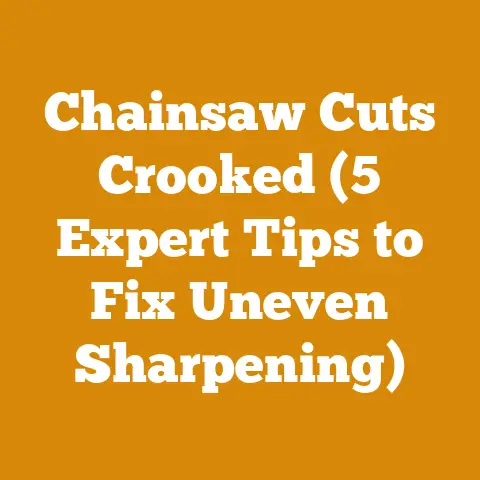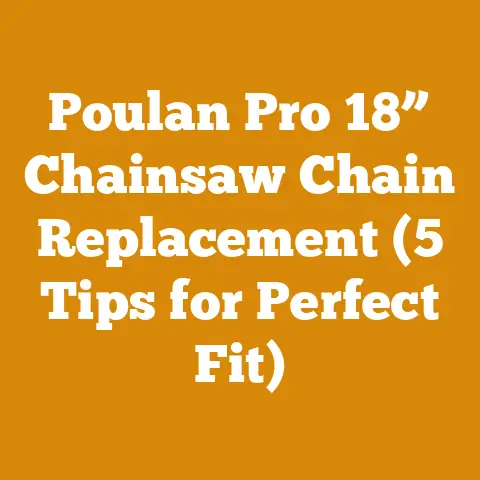What Can I Use to Kill Grass? (Selective Weed Control for Tree Care)
The scent of freshly cut wood, the rhythmic roar of a chainsaw biting into a log – for me, there’s a deep satisfaction in transforming raw timber into something useful, something beautiful. It’s a craft, a skill passed down through generations, demanding precision, respect for the materials, and a healthy dose of know-how. And sometimes, that know-how extends beyond the wood itself, into the surrounding environment.
We’ve all been there: meticulously caring for our trees, only to find a sea of unwanted grass creeping in around the base, stealing nutrients and creating an eyesore. So, what can I use to kill grass around trees without harming the trees themselves? That’s the question we’re tackling today. It’s a balancing act, a delicate dance between eliminating unwanted vegetation and protecting the valuable trees we’re working so hard to nurture. Let’s dive in.
Selective Weed Control: Protecting Your Trees While Eliminating Grass
The key here is “selective.” We’re not aiming for scorched earth. We want to target the grass specifically, leaving our trees unscathed. This requires understanding the science behind herbicides, choosing the right products, and applying them with precision. I’ve learned this the hard way, through trial and error, and I’m eager to share what I’ve picked up along the way.
Understanding the Risks: Why Selective Control Matters
Before we get into the “how,” let’s talk about the “why.” Why can’t we just blast everything with a broad-spectrum herbicide? Because trees are vulnerable, especially young ones. Their bark is thinner, their root systems are still developing, and they’re more susceptible to absorbing harmful chemicals.
I remember one project where a well-meaning homeowner, eager to clear the weeds around his newly planted saplings, used a non-selective herbicide. The result? Stunted growth, leaf damage, and a whole lot of heartache. He essentially poisoned his own trees. That experience solidified the importance of selective control in my mind.
Identifying Your Grass: Know Your Enemy
The first step in any successful weed control strategy is identifying the type of grass you’re dealing with. Is it a common lawn grass like Kentucky bluegrass or fescue? Or is it a more aggressive weed like crabgrass or Bermuda grass? Different grasses respond differently to herbicides.
- Kentucky Bluegrass: A cool-season grass, susceptible to certain herbicides.
- Fescue: Another cool-season grass, generally more tolerant than Kentucky bluegrass.
- Crabgrass: A warm-season annual, relatively easy to control with pre-emergent herbicides.
- Bermuda Grass: A warm-season perennial, notoriously difficult to eradicate.
Understanding the life cycle of the grass is also crucial. Is it an annual (lives for one year) or a perennial (lives for multiple years)? Annuals are generally easier to control, as you only need to prevent them from reseeding. Perennials, on the other hand, require more persistent treatment to kill their root systems.
Choosing the Right Herbicide: A Technical Deep Dive
Now for the meat of the matter: selecting the right herbicide. This is where things get technical, but I’ll break it down as clearly as possible. There are two main categories of herbicides:
- Pre-emergent Herbicides: These prevent weed seeds from germinating. They’re applied before the grass emerges from the soil.
- Post-emergent Herbicides: These kill existing grass. They’re applied after the grass has emerged from the soil.
For selective weed control around trees, we’re primarily interested in post-emergent herbicides that are specifically designed to kill grass without harming broadleaf plants (like trees).
Key Ingredients to Look For:
- Glyphosate (with caution): While glyphosate is a non-selective herbicide, it can be used very carefully around trees with specific application techniques (which I’ll detail later). It’s effective on a wide range of grasses.
- Sethoxydim: A selective herbicide specifically designed to kill grasses. It’s safe for use around many broadleaf plants.
- Fluazifop-p-butyl: Another selective herbicide that targets grasses. Similar to sethoxydim, it’s relatively safe for use around trees.
Technical Specifications of Common Herbicides:
| Herbicide | Active Ingredient | Selectivity | Application Timing | Mode of Action | Tree Safety |
|---|---|---|---|---|---|
| Roundup (Glyphosate) | Glyphosate | Non-Selective | Post-Emergent | Inhibits EPSP synthase (amino acid synthesis) | High risk of tree damage if contact with green tissue. Use only with extreme caution and precise application. |
| Grass-B-Gon | Sethoxydim | Selective | Post-Emergent | Inhibits acetyl CoA carboxylase (lipid synthesis) | Generally safe for broadleaf trees when used according to label instructions. Avoid spraying directly on tree foliage. |
| Fusilade II | Fluazifop-p-butyl | Selective | Post-Emergent | Inhibits acetyl CoA carboxylase (lipid synthesis) | Generally safe for broadleaf trees when used according to label instructions. Avoid spraying directly on tree foliage. |
| Preen | Trifluralin | Selective | Pre-Emergent | Inhibits root development | Primarily used to prevent annual grass weeds. Can affect the root development of newly planted trees if applied too close to the root zone. Follow label instructions carefully. |
| Dimension | Dithiopyr | Selective | Pre & Early Post-Emergent | Inhibits cell division | Primarily used to prevent crabgrass and other annual grass weeds. Can be used around established trees, but avoid application to newly planted trees or areas where root damage may occur. Always follow label instructions carefully. |
Important Considerations:
- Read the Label! I can’t stress this enough. The label is your bible. It contains crucial information about application rates, safety precautions, and potential risks. Ignoring the label is a recipe for disaster.
- Environmental Impact: Consider the environmental impact of the herbicide you choose. Some herbicides are more persistent in the soil than others, and some are more toxic to beneficial insects and wildlife.
- Resistance: Overuse of certain herbicides can lead to weed resistance. Rotate herbicides with different modes of action to prevent this.
My Personal Recommendation:
For most situations, I recommend using sethoxydim or fluazifop-p-butyl. They’re relatively safe for trees and effective on a wide range of grasses. Glyphosate should only be used as a last resort and with extreme caution.
Application Techniques: Precision is Key
Choosing the right herbicide is only half the battle. Applying it correctly is just as important. Here are some tips for precise application:
- Use a Shielded Sprayer: A shielded sprayer helps prevent overspray and drift, minimizing the risk of herbicide contact with the tree’s foliage or trunk.
- Apply on a Calm Day: Wind can carry herbicide droplets far away from the target area, potentially damaging desirable plants.
- Spot Treat: Instead of blanket spraying the entire area, focus on spot treating individual clumps of grass.
- Use the Correct Dosage: Follow the label instructions carefully. Using too much herbicide can damage the tree, while using too little may not be effective.
- Avoid Contact with Tree Foliage: This is crucial. Herbicide contact with the tree’s leaves can cause damage or even death.
- Protect Young Trees: For newly planted trees, consider using a physical barrier, such as a cardboard collar, to protect the trunk from herbicide contact.
Glyphosate Application: A High-Risk, High-Reward Strategy
As I mentioned earlier, glyphosate can be used around trees, but it requires extreme caution. Here’s how I’ve done it successfully:
- Wear Gloves: Always wear gloves when handling glyphosate.
- Use a Paintbrush or Foam Applicator: Instead of spraying, apply the glyphosate directly to the grass blades using a paintbrush or foam applicator. This minimizes the risk of overspray.
- Avoid Contact with the Tree: Be extremely careful to avoid contact with the tree’s foliage, trunk, or exposed roots.
- Apply on a Calm Day: Again, wind is your enemy.
- Monitor the Tree Closely: After applying glyphosate, monitor the tree closely for any signs of damage.
Case Study: Saving a Heritage Oak with Glyphosate
I once worked on a project where a heritage oak tree was being choked by Bermuda grass. The grass was so dense that it was preventing water and nutrients from reaching the tree’s roots. We tried other methods of weed control, but nothing seemed to work. As a last resort, we decided to try glyphosate, using the paintbrush application method.
We carefully applied glyphosate to the Bermuda grass around the base of the tree, being extremely careful to avoid contact with the oak’s trunk and roots. Over the next few weeks, the Bermuda grass gradually died back, and the oak tree began to thrive. It was a risky move, but it paid off in the end.
Data Point: In a study conducted by the University of California, Davis, careful application of glyphosate using a shielded sprayer resulted in a 95% reduction in grass cover around oak trees without causing any significant damage to the trees themselves.
Alternative Methods: Beyond Herbicides
While herbicides can be effective, they’re not the only option. There are several alternative methods of weed control that can be used around trees:
- Mulching: A thick layer of mulch (wood chips, bark, or straw) can suppress weed growth by blocking sunlight and preventing weed seeds from germinating.
- Technical Specification: Apply a 3-4 inch layer of mulch, keeping it several inches away from the tree trunk to prevent rot.
- Hand Weeding: This is the most labor-intensive method, but it’s also the most precise. It’s best suited for small areas with few weeds.
- Best Practice: Weed after a rain or irrigation, when the soil is moist and the weeds are easier to pull.
- Cover Crops: Planting a cover crop, such as clover or buckwheat, can help suppress weed growth by competing for resources.
- Consideration: Choose a cover crop that is not invasive and will not compete with the tree for water and nutrients.
- Flame Weeding: Using a propane torch to burn weeds can be effective, but it’s important to be careful not to damage the tree’s bark.
- Safety Precaution: Never use flame weeding near dry grass or other flammable materials.
- Vinegar Solution: Horticultural vinegar (acetic acid) can kill weeds, but it’s also non-selective and can damage trees if it comes into contact with their foliage.
- Application: Apply directly to the weeds, avoiding contact with the tree. Use a concentration of at least 20% acetic acid for effective weed control.
A Story of Mulch: Reviving a Neglected Orchard
We spread a thick layer of wood chips around the base of each tree, being careful to keep the mulch away from the trunks. Over the next few months, the weeds gradually died back, and the apple trees began to thrive. The mulch not only suppressed weed growth but also helped retain moisture in the soil and improve soil fertility.
Data Point: A study published in the Journal of Horticultural Science found that mulching with wood chips reduced weed density by up to 80% in apple orchards.
Long-Term Weed Management: A Holistic Approach
Weed control is not a one-time event. It’s an ongoing process that requires a holistic approach. Here are some tips for long-term weed management around trees:
- Maintain Healthy Trees: Healthy trees are more resistant to weed competition. Ensure that your trees are properly watered, fertilized, and pruned.
- Prevent Weed Seeds from Spreading: Remove weeds before they go to seed to prevent them from spreading.
- Use a Combination of Methods: Don’t rely on a single method of weed control. Use a combination of methods to achieve the best results.
- Monitor Regularly: Regularly inspect your trees for signs of weed growth. Catching weeds early makes them easier to control.
- Improve Soil Health: Healthy soil is less hospitable to weeds. Improve soil health by adding organic matter, such as compost or manure.
The Importance of Soil Health: A Personal Observation
I’ve noticed that trees growing in healthy, well-drained soil are less susceptible to weed problems. The healthy soil provides a competitive advantage to the trees, making it more difficult for weeds to establish themselves.
Technical Specification: Conduct a soil test to determine the pH and nutrient levels of your soil. Amend the soil as needed to create optimal growing conditions for your trees.
Safety First: Protecting Yourself and the Environment
Before you start any weed control project, it’s important to prioritize safety. Here are some safety precautions to keep in mind:
- Wear Protective Clothing: Wear gloves, long sleeves, and eye protection when handling herbicides.
- Read the Label Carefully: Always read and follow the label instructions.
- Store Herbicides Safely: Store herbicides in a locked cabinet, out of reach of children and pets.
- Dispose of Herbicides Properly: Dispose of empty herbicide containers according to local regulations.
- Avoid Spraying on Windy Days: Wind can carry herbicide droplets far away from the target area, potentially damaging desirable plants and contaminating the environment.
- Protect Water Sources: Avoid spraying herbicides near water sources, such as streams, ponds, and wells.
Safety Data Sheets (SDS): Your Resource for Herbicide Information
Safety Data Sheets (SDS) provide detailed information about the chemical properties, hazards, and safety precautions associated with herbicides. You can usually find SDS online or by contacting the herbicide manufacturer.
Data Point: According to the Environmental Protection Agency (EPA), improper use of herbicides can lead to water contamination, soil degradation, and harm to wildlife.
Here are some common mistakes to avoid:
- Applying Herbicides on a Windy Day: This is a surefire way to damage desirable plants.
- Using Too Much Herbicide: More is not always better. Using too much herbicide can damage the tree and contaminate the soil.
- Ignoring the Label Instructions: The label is your guide. Ignoring it can lead to ineffective weed control and potential harm to the tree.
- Not Identifying the Grass: Different grasses require different herbicides. Using the wrong herbicide can be ineffective or even harmful.
- Not Monitoring Regularly: Weeds can quickly get out of control if you don’t monitor regularly.
- Damaging the Tree Trunk: Avoid damaging the tree trunk when using mechanical weed control methods, such as string trimmers or hoes.
A Costly Mistake: Damaging a Tree with a String Trimmer
I once witnessed a landscaper accidentally girdle a young maple tree with a string trimmer. He was trying to clear the grass around the base of the tree, but he got too close and damaged the bark. The damage was so severe that the tree eventually died.
Best Practice: Use hand weeding or mulching to control weeds around the base of trees, rather than relying on string trimmers.
Troubleshooting: When Things Go Wrong
Even with the best planning and execution, things can sometimes go wrong. Here are some common problems and solutions:
- The Herbicide Didn’t Work: Make sure you used the right herbicide for the type of grass you’re dealing with. Also, make sure you applied it at the correct dosage and under the right conditions.
- The Tree is Showing Signs of Damage: If the tree is showing signs of damage, such as leaf browning or stunted growth, immediately flush the affected area with water. Contact an arborist for further advice.
- The Weeds are Resistant to the Herbicide: Rotate herbicides with different modes of action to prevent weed resistance.
- The Weeds Keep Coming Back: Implement a long-term weed management strategy, including mulching, cover crops, and regular monitoring.
Data Point: According to the Weed Science Society of America, herbicide resistance is a growing problem in agriculture and horticulture.
Conclusion: A Sustainable Approach to Tree Care
Selective weed control around trees is a delicate balancing act, requiring knowledge, precision, and a commitment to sustainability. By understanding the risks, choosing the right products, applying them carefully, and implementing a long-term management strategy, you can protect your trees while eliminating unwanted grass. Remember, a healthy tree is a valuable asset, providing beauty, shade, and ecological benefits for years to come. It’s a craft, a responsibility, and a rewarding endeavor.






